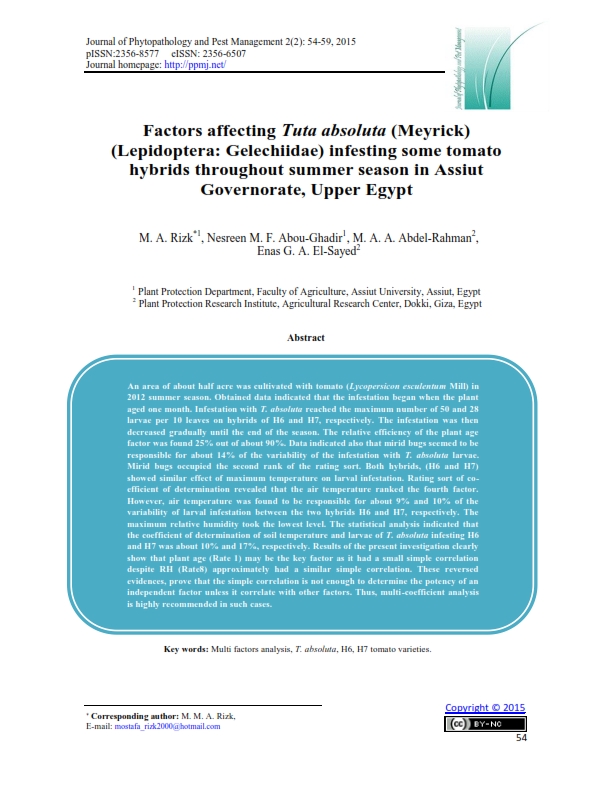Factors affecting Tuta absoluta (Meyrick) (Lepidoptera: Gelechiidae) infesting some tomato hybrids throughout summer season in Assiut Governorate, Upper Egypt
Keywords:
Multi factors analysis, T. absoluta, H6, H7 tomato varieties.Abstract
An area of about half acre was cultivated with tomato (Lycopersicon esculentum Mill) in 2012 summer season. Obtained data indicated that the infestation began when the plant aged one month. Infestation with T. absoluta reached the maximum number of 50 and 28 larvae per 10 leaves on hybrids of H6 and H7, respectively. The infestation was then decreased gradually until the end of the season. The relative efficiency of the plant age factor was found 25% out of about 90%. Data indicated also that mirid bugs seemed to be responsible for about 14% of the variability of the infestation with T. absoluta larvae. Mirid bugs occupied the second rank of the rating sort. Both hybrids, (H6 and H7) showed similar effect of maximum temperature on larval infestation. Rating sort of co-efficient of determination revealed that the air temperature ranked the fourth factor. However, air temperature was found to be responsible for about 9% and 10% of the variability of larval infestation between the two hybrids H6 and H7, respectively. The maximum relative humidity took the lowest level. The statistical analysis indicated that the coefficient of determination of soil temperature and larvae of T. absoluta infesting H6 and H7 was about 10% and 17%, respectively. Results of the present investigation clearly show that plant age (Rate 1) may be the key factor as it had a small simple correlation despite RH (Rate8) approximately had a similar simple correlation. These reversed evidences, prove that the simple correlation is not enough to determine the potency of an independent factor unless it correlate with other factors. Thus, multi-coefficient analysis is highly recommended in such cases.
Metrics

Published
How to Cite
Issue
Section
License
Authors who publish with Journal of Phytopathology and Disease Management agree to the following terms:
- Authors retain copyright and grant the journal right of first publication with the work simultaneously licensed under a Creative Commons Attribution License that allows others to share the work with an acknowledgement of the work's authorship and initial publication in this journal.
- Authors retain copyright and grant the journal right of first publication with the work simultaneously licensed under the Creative Commons Attribution-Non Commercial License (CC BY-NC). This allows others to share the work with an acknowledgement of the work's authorship and initial publication in this journal.
- Archives of Agricultural Sciences Journal is an Open Access Journal, and articles published are distributed under the terms of the Creative Commons Attribution-Non Commercial License (CC BY-NC). Readers may copy, distribute, and display the work for non commercial purposes with the proper citation of the original work. However, the journal retains the right to exploit subsidiary rights on behalf of the authors.
- Authors are able to enter into separate, additional contractural arrangements for the non-exclusive distribution of the journal's published version of the work (e.g. post it to an institutional repository or publish it in a book), with an acknowledgement of its initial publication in this journal.
- Authors are permitted and encouraged to post their work online (e.g., in institutional repositories or on their website) prior to and during the submission process with full disclosure to the journal, as it can lead to productive exchanges, as well as earlier and greater citation of published work. Following publication in Archives of Agricultural Sciences Journal, the author should update the repository, and include a citation and link to the published work.
Click here for more information on Licensing policy
.png)




